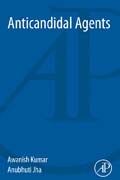
Anticandidal Agents is apt for providing thorough information on Candida drug resistance and its remedial implications. With this compilation we provide a comprehensive view on overcoming resistance in anticandidal drugs along with information on novel molecules. Candida albicans is an opportunistic pathogenic fungus responsible for life threating invasive and nosocomial infections across the globe. Candidiasis is a major cause of morbidity among immunocompromised patients. Infections caused by non-albicans Candida like C. glabrata, C. parapsilosis, C. tropicalis have also imposed a serious threat in the last few decades. Current treatment of candidiasis relies primarily on antifungal agents broadly categorized as azoles, polyenes, echinocandins, allylamines and pyrimidines. Lately antifungal resistance has emerged to be an obstruction of current treatment regime. A number of reasons are accountable for occurrence of resistance that is well described in detail. Understanding the mechanisms of resistance is crucial for developing strategies for overcoming the hindrance in current therapeutics. A eukaryotic fungal cell share significant similarity with human cells. Due to dearth of selective fungal targets, ineffective drugs and severity of infection there is ardent need of new antifungal agents. Incompetence of the existing treatment is evident by high mortality and morbidity patient data. Henceforth both new drug targets and new drug leads are equally needed. Moreover as compared to antibacterials that have developed over time; the growth of antifungals has always lagged behind. Therefore antifungal pipeline is evidently dry with resistance as its major barrier. A complete understanding of Candida resistance helps in therapeutic expansion by development of novel drugs. A complete understanding of Candida resistance helps in therapeutic expansion by development of novel drugsProvides thorough information on Candida drug resistance and its remedial implicationsUnderstanding the mechanisms of resistance is crucial for developing strategies for overcoming the hindrance in current therapeutics INDICE: 1: Introduction 2: Host Pathogen interaction, Morphogenesis and Immune response 3: Antifungals used against candidiasis 4. Drug resistance in candida 5. MDR and transporters 6. Potential targets for anticandidal agents 7. Conclusion 8. References/ Bibliography
- ISBN: 978-0-12-811311-0
- Editorial: Academic Press
- Encuadernacion: Rústica
- Páginas: 140
- Fecha Publicación: 01/09/2016
- Nº Volúmenes: 1
- Idioma: Inglés
